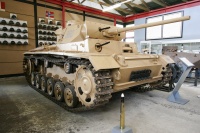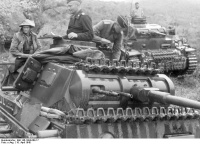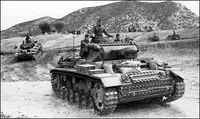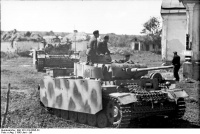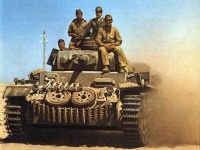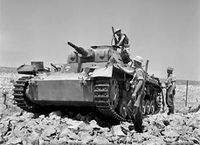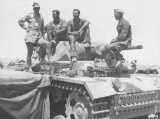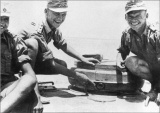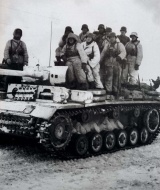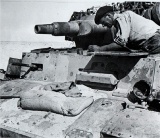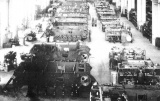Pz.Kpfw. III Ausf. J
| Revision as of 22:06, 23 February 2011 | Revision as of 06:18, 26 February 2011 | |||
| Line 34: | Line 34: | |||
| |isSPGorTD= | |isSPGorTD= | |||
| ? | |gun1=1,3.7cm KwK 36 L/46.5, 32/38/42 , 34/64/18 , 30, 1 000 , 100 | + | |gun1=1,3.7cm KwK 36 L/46.5, 32/38/42 , 34/64/18 ,30, 0.40 ,1 000 , 100 | |
| ? | |gun2=2, 2cm Flak 38 L/112, 11/11 , 39/51 , 109.09 , 3 160 , 110 | + | |gun2=2, 2cm Flak 38 L/112, 11/11 , 39/51 , 109.09 , 0.39 ,3 160 , 110 | |
| ? | |gun3=3, 5cm KwK 38 L/42, 70/70/90 , 60/96/25 , 27.27 , 6 970, 700 | + | |gun3=3, 5cm KwK 38 L/42, 70/70/90 , 60/96/25 , 27.27, 0.42 ,6 970, 700 | |
| ? | |gun4=3, 5 cm KwK 39 L/60, 70/70/90, 67/130/25, | + | |gun4=3, 5 cm KwK 39 L/60, 70/70/90, 67/130/25,27.27,0.33,8 570,700 | |
| ? | |gun5=3, 7.5 cm KwK 37 L/24, 110/110/175, | + | |gun5=3, 7.5 cm KwK 37 L/24, 110/110/175,43/100/38,16, 0.48 ,10 450,780 | |
| |turret1=3, PzKpfw-III-Turm Ausf. E, 50/30/30 , 53 , 380 , 2 290 , 2 200 | |turret1=3, PzKpfw-III-Turm Ausf. E, 50/30/30 , 53 , 380 , 2 290 , 2 200 | |||
Revision as of 06:18, 26 February 2011
PzKpfw III
| Germany | Medium Tank | Tier IV |
| Cost | 182,500 |
|---|---|
| Health | 310 |
| Weight/Load Limit | 18.05/19.25t |
| Engine Power | 320hp |
| Speed Limit | 64km/h |
| Traverse Speed | 40deg/s |
| Hull Armor | 70/30/50mm |
| Turret Armor | 50/30/30mm |
| Damage | 24-40HP |
| Penetration | 26-43mm |
| Rate of Fire | 30r/m |
| Accuracy | 0.4m |
| Aim time | 1.5s |
| Turret Traverse | 53deg/s |
| Gun Traverse Arc | gunTraverseArc |
| Gun Vertical Limits | gunVerticalLimits |
| Ammo Capacity | ammo |
| Chance of Fire | 25% |
| View Range | 380m |
| Signal Range | 350m |
| Parent | parent |
| Child | child |
The Tier 4 PzKpfw III is one of the best scouts in the German tech tree, second only to Leopard. The tank is a little bit slower and less agile then Leopard, but it has thicker armor (although not sloped) and it will be matched against lower tier tanks more often then not. Choice of the main weapon between 5 cm KwK 39 L/60 and 7.5 cm KwK 37 L/24 depends on individual preferences, but both guns are effective against light tanks and SPG's, PzKpfw III's primary targets.
- Research along the PzKpfw II tree leads to a pair of Tier 5 tanks: the PzKpfw IV Medium Tank and the PzKpfw III/IV Medium Tank.
Modules
|
Historical Info
Following specifications laid down by Heinz Guderian, in 1934 the Army Weapons Department drew up plans for a medium tank with a maximum weight of 24,000 kg and a top speed of 35 kilometres per hour (21.75 mph). It was intended as the main tank of the German Panzer divisions, capable of engaging and destroying opposing tank forces. Daimler-Benz, Krupp, MAN, and Rheinmetall all produced prototypes. Testing of the prototypes took place in 1936 and 1937, leading to the Daimler-Benz design being chosen for production. The first model of the Panzer III, the Ausf. A, came off the assembly line in May 1937, while mass production of the Ausf. F version began in 1939. Much of the early development work on the Panzer III was a quest for a suitable suspension. Several varieties of leaf-spring suspensions were tried on Ausf. A through Ausf. D before the torsion-bar suspension of the Ausf. E was standardized. The Panzer III, along with the Soviet KV heavy tank, was one of the first tanks to use this suspension design.
A distinct feature of Panzer III was a three-man turret. This meant that commander was not distracted with neither loader's or gunner's tasks and could fully concentrate on maintaining situational awareness. Other tanks of the time did not have this capability, providing the Panzer III with a potential combat advantage.The Panzer III was intended as the primary battle tank of the German forces. However, when it initially met the KV and T-34 tanks it proved to be inferior in both armor and gun power. To meet the growing need to counter these tanks, the Panzer III was up-gunned with a longer, more powerful 50-millimetre cannon and received more armour although this failed to effectively address the problem caused by the KV tank designs. As a result, production of self-propelled guns, as well as the up-gunning of the Panzer IV was initiated.
In 1942, the final version of the Panzer III, the Ausf. N, was created with a 75-millimetre KwK 37 L/24 cannon, a low-velocity gun designed for anti-infantry and close-support work. For defensive purposes, the Ausf. N was equipped with HEAT ammunition which could penetrate 70 to 100 millimetres of armour, but these were strictly used for self-defense as this variant of the tank was not intended for anti tank role.
Starting with Ausführung E. from December 1938, through February 1943, a total of 4,958 tanks and 321 commander's vehicles were produced.
Armour and Mobility
The Panzer III Ausf. A through C had 15 millimetres of homogeneous steel armor on all sides with 10 millimetres on the top and 5 millimetres on the bottom. This was quickly determined to be insufficient, and was upgraded to 30 millimetres on the front, sides and rear in the Ausf. D, E, F, and G models, with the H model having a second 30-millimetre layer of face-hardened steel applied to the front and rear hull. The Ausf. J model had a solid 50-millimetre (1.97 in) plate on the front and rear, while the Ausf. J¹, L, and the M models had an additional layer of 20 millimetres (0.79 in) of armor on the front hull and turret. This additional frontal armor gave the Panzer III frontal protection from most British and Soviet anti-tank guns at all but close ranges. The sides were still vulnerable to many enemy weapons including anti-tank rifles at close ranges. The Panzer III Ausf. A through C were powered by a 250 horsepower (183.87 kW), 12-cylinder Maybach HL 108 TR engine, giving a top speed of 32 kilometres per hour (19.88 mph) and a range of 150 kilometres (93.21 mi). All later models were powered by the 300 horsepower (220.65 kW), 12-cylinder Maybach HL 120 TRM engine. Top speed varied, depending on the transmission and weight, but was around 40 kilometres per hour. The range was generally around 155 kilometres.
Firepower
The Panzer III was intended to fight other tanks; in the initial design stage a 50-millimetre cannon was specified. However, the infantry at the time were being equipped with the 37-millimetre PaK 36, and it was thought that in the interest of standardization the tanks should carry the same armament. As a compromise, the turret ring was made large enough to accommodate a 50-millimetre cannon should a future upgrade be required. This single decision would later assure the Panzer III a prolonged life in the German army. The Ausf. A to early Ausf. F were equipped with a 3.7 cm KwK 36 L/46.5 which proved adequate during the campaigns of 1939 and 1940 but the later Ausf. F to Ausf. J were upgraded with the 5 cm KwK 38 L/42 and the Ausf. J to M with the longer 5 cm KwK 39 L/60 cannon in response to increasingly better armed and armoured opponents. By 1942, the Panzer IV was becoming Germany's main medium tank because of its better upgrade potential. The Panzer III remained in production as a close support vehicle. The Ausf. N model mounted a low-velocity 7.5 cm KwK 37 L/24 cannon - the same used by the early Panzer IV Ausf. A to Ausf. F models. These guns had originally been fitted to older Panzer IV Ausf A to F1 models and had been placed into storage when those tanks had also been up armed to longer versions of the 75mm gun. All early models up to and including the Ausf. F had two 7,92 mm MG 34 machine guns mounted coaxially with the main gun, and a similar weapon in a hull mount. Models from the Ausf. G and later had a single coaxial MG34 and the hull MG34.
Combat history
The Panzer III was extensively used in the campaigns against Poland, France, the Soviet Union and in North Africa, while a handful were still in use in Normandy and at Arnhem in 1944.
In the Polish and French campaigns, the Panzer III formed a small part of the German armored forces. Only a few hundred Ausf. A through F were available in these campaigns, most armed with the 37-millimetre gun. They were the best medium tank available to the Germans and outclassed most of their opponents such as the Polish 7TP, French R-35 andH-35 light tanks.
Prior to the invasion on Soviet Union, the Panzer III was numerically the most important German tank. At this time the majority of the available tanks had the 50 millimetre KwK 38 L/42 cannon which also equipped the majority of the tanks in North Africa. Initially, the Panzer IIIs were outclassed and outnumbered by Soviet T-34 and KV tanks. However, the most numerous Soviet tanks were the T-26 and BT tanks. This, along with superior German tactical skill, crew training, and the good ergonomics of the Panzer III all contributed to a rough 6:1 favourable kill ratio for German tanks of all types in 1941. With the appearance of the T-34 and KV tanks, rearming the Panzer III with a longer, more powerful 50-millimetre cannon was prioritised. The T-34 was generally invulnerable in frontal engagements with the Panzer III until the 50 mm KwK 39 L/60 gun was introduced on the Panzer III Ausf. J¹ in the spring of 1942.
This could penetrate the T-34 frontally at ranges under 500 metres. Against the KV tanks it was a threat if armed with special high velocity tungsten rounds. In addition, to counter antitank rifles, in 1943 the Ausf. L version began the use of spaced armour skirts around the turret and on the hull sides. However, due to the introduction of the upgunned and uparmoured Panzer IV, the Panzer III was, after the Battle of Kursk, relegated to secondary roles, and it was replaced as the main German medium tank by the Panzer IV and the Panther.
The Panzer III chassis was the basis for the turretless Sturmgeschütz III (StuG III) assault gun, one of the most successful self-propelled guns of the war, and the single most-produced German armored fighting vehicle design of World War II.
By the end of the war, the Pz.III had almost no frontline use and many exemplars had been returned to the factories for conversion into StuG assault guns, which were in high demand due to the defensive warfare style adopted by the German Army by then.






